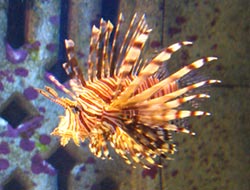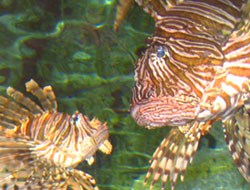Red Lionfish (Pterois volitans) and Devil Firefish (Pterois miles)
Scorpionfish family (Scorpaenidae)
 Native to the Indo-Pacific, the red lionfish invasion in the Western Atlantic, Caribbean and Gulf of Mexico represents one of the most rapid marine finfish invasions in history.
Native to the Indo-Pacific, the red lionfish invasion in the Western Atlantic, Caribbean and Gulf of Mexico represents one of the most rapid marine finfish invasions in history.
Primarily inhabiting reefs, and found in depths ranging from 1 to 175 meters, they feed on small fish and crustaceans. A well camouflaged, nocturnal species, lionfish range from 6-12 inches in length and are covered with venomous spines on their dorsal, ventral and anal fins. Juveniles tend to live in small groups, but adults are solitary creatures.
Devil firefish (Pterois miles) is another species of lionfish. Also native to the Indo-Pacific, a few have been found in the Caribbean and Western Atlantic. However, more than 90 percent of lionfish sited in the introduced range are red lionfish.
Expanded Range
Lionfish were most likely introduced in the Western Atlantic, Caribbean and Gulf of Mexico through the aquarium trade. During Hurricane Andrew in 1992, six fish were known to escape in the storm. Also, lionfish have been intentionally as well as accidentally released by owners.
Their first reported sighting in the Florida Keys was in January 2009, but red lionfish were established in Bermuda by 2004. In September 2010, lionfish were reported near oil rigs off the coast of Louisiana. Cool water was expected to limit the range of lionfish in the Northwestern Atlantic, but lionfish have been found in water as cold as 56 °F.
For a current map depicting lionfish distribution, visit the U.S. Geological Survey Nonindigenous Aquatic Species page .
Native Habitat, Ecology and Impacts
 Many reefs throughout the Caribbean have been altered by lionfish. They are predatory, meaning they will consume many reef fish including damselffish and cardinal fish. Lionfish can significantly reduce native fish populations on a coral or artificial reef, affecting the ecosystem’s balance. And with its characteristic venomous spines, very little else will eat lionfish, making them an upper-level predator in the Atlantic, Gulf and Caribbean. Their spines are poisonous to humans, as well as, creating new hazards for snorkleers and scuba divers.
Many reefs throughout the Caribbean have been altered by lionfish. They are predatory, meaning they will consume many reef fish including damselffish and cardinal fish. Lionfish can significantly reduce native fish populations on a coral or artificial reef, affecting the ecosystem’s balance. And with its characteristic venomous spines, very little else will eat lionfish, making them an upper-level predator in the Atlantic, Gulf and Caribbean. Their spines are poisonous to humans, as well as, creating new hazards for snorkleers and scuba divers.
What to do if you encounter a lionfish:
Be careful! Red lionfish are harmful and can sting humans. Use extreme caution if you choose to handle these fish. PVC gloves or gaff are recommended.
Report any fish you see to:
If stung:
Stings from lionfish can be serious and should not be taken lightly. If stung, immerse the wound in hot water (100-110 °F or 38-43 °C) for 15-20 minutes, but do not burn the skin. Seek medical attention as soon as possible. It is recommended that you call the Aquatic Toxins Hotline (888-232-8635) at the Florida Poison Information Center in Miami, where medical experts will advise you. This hotline is available 24 hours a day, seven days a week.
How to help:
Do not release aquarium pets and fish into the wild. Aquarium animals are often not native and can lead to problems if they survive in the wild. Even if it is a native fish or animal, it is no longer adapted to the wild. See Habitattitude for more information.
Additional information: